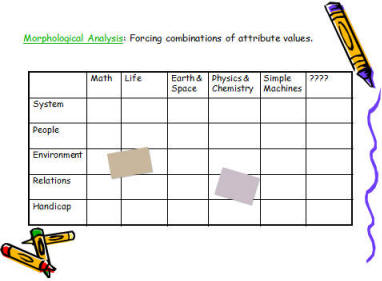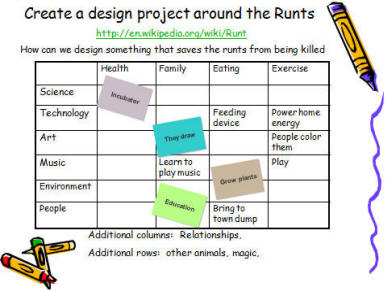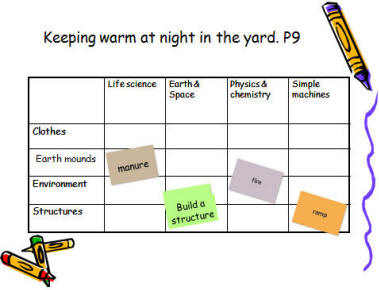|
|
Morphological Analysis |
|
|
|
![]()
| Templates |
| Instructions |
DecompositionA simple, but effective, principle used in some creative methods and problem-solving approaches is to break down the situation or item under scrutiny into its component parts. When things are broken down in this way, then each part may be scrutinized and understood independently (as well as individually improved). Decomposition thus uses a 'divide and conquer' approach. A danger in decomposition is that improving parts does not always improve the whole, and can even cause unforeseen problems.
|
|
|
||||||||||||
|
Essential Questions:
|
||||||||||||
|
The Concept of the Morphological Analysis is a way of automatically combining the parameters of a challenge into new ideas( parameter here means characteristics, attributes, factors variable or aspect).
How to set up the morphological table |
|
taken from: http://creatingminds.org/tools/morphological.htm Define the problem Identify the objective of the creative session, defining the problem in a short and clear statement. Identify attributes and valuesList the things about the situation that can be varied or changed in some way. Select a subset of two to six variables to investigate further. These will normally be significant parts of the situation. For each of the variables from step 3, list possible values they may have, including those away from the conventional values (you can be creative at this step too). Combing itemsFind a way of combining items from the lists you have created. If there are only two lists, then a matrix may be used as in the example below. Another way is to have six variable in each list and throw one die per list to select items to combine. You could also write them on cards and pick them from six ‘hats’ (the methods are as many as you can imagine). Repeatedly combine selections of ideas generated, forcing all items together to build a creative solution. Do not worry too much at this time if the ideas are not particularly feasible as they may be developed at a later stage or used to trigger other creative possibilities. Select ideas to use or develop into practical solutions to your problem. ExampleAn artist, looking for new ways of creating artwork, identifies two attributes, 'materials' and 'canvas', and then lists the values these can take (e.g. 'ink' is a value of 'materials'). She then brings these together in the table below to explore possible combinations.
How it worksDespite its wonderful name (given to it by its originator, Fritz Zwicky), Morphological Analysis works through very simple processes, using two common principles of creativity: decomposition and forced association. The problem is broken down into component variables and possible values identified for each. The association principle is then brought into play by ‘banging together’ multiple combinations of these values.
|
|||||||||||||||||||||||||||||||||||
 |
|||||||||||||||||||||||||||||||||||
 |
|||||||||||||||||||||||||||||||||||
 |
|||||||||||||||||||||||||||||||||||
Last Updated 02/06/2010